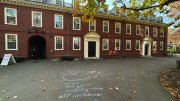Impressionist Children: Childhood, Family, and Modern Identity in French Art, by Greg M. Thomas, Ph.D. ’95 (Yale, $65). Analyzing works iconic and otherwise from afar (he is chair of fine arts at the University of Hong Kong), the author decodes art to “illuminate adults’ imaginings” about the little ones’ lives.
Justice for Hedgehogs, by Ronald Dworkin ’53, LL.B. ’57, LL.D. ’09 (Harvard, $35). The legal and moral philosopher (of NYU and University College London) delivers perhaps his most imposing book: a wide contemplation of value and skepticism, in which he broaches basic, hard issues: “It is always appropriate to ask why morality requires what we say it does, and never appropriate to say: it just does.”
It Happened on the Way to War: A Marine’s Path to Peace, by Rye Barcott, M.P.A.-M.B.A. ’09 (Bloomsbury, $26). From founding a nongovernmental organization in the Kibera slum of Nairobi to serving as a marine intelligence officer in Iraq and elsewhere, the author vividly describes a young life bridging radically different kinds of service.
Sex and the River Styx, by Edward Hoagland ’54 (Chelsea Green, $27.50; $17.95 paper). This tenth collection of essays (and that’s but half his output) finds the author again exploring subjects from his interior state of mind to the world’s wild places and people, from a more aged perspective: “There’s a flutter to society now, a tremulousness,” one piece begins.
Agewise: Fighting the New Ageism in America, by Margaret Morganroth Gullette ’62, Ph.D. ’75, RI ’87 (Chicago, $29). A full-throated analysis of and attack on a pernicious new “ism.” Sample chapter title: “Hormone Nostalgia.”
Changing Planet, Changing Health, by Paul R. Epstein, associate director, Center for Health and Global Environment, and Dan Ferber (California, $29.95). The bad news about the effects of climate change on water supply; favorable habitats for disease-bearing ticks; and why warmer oceans promote cholera. With ideas for better outcomes.
Give Smart, by Thomas J. Tierney, M.B.A. ’80, and Joel L. Fleishman (PublicAffairs, $23.99). The authors—a Bain leader and then founder of Bridgespan Group, and a Duke scholar of philanthropy, respectively—provide a primer on “philanthropy that gets results.”
Confederate Minds, by Michael T. Bernath, Ph.D. ’05 (North Carolina, $39.95). In this Civil War sesquicentennial year, the University of Miami historian delivers a sweeping overview of the neglected intellectual and cultural currents accompanying the Southern struggle for political and national independence.
Heat & Light: Advice for the Next Generation of Journalists, by Mike Wallace and Beth Knobel, M.P.P ’87, Ph.D. ’92 (Three Rivers/Crown, $14 paper). A veteran journalist and a Fordham University assistant professor of communication and media studies merit some attention—if only for their hopeful subtitle alone.
The Elusive West and the Contest for Empire, 1713-1763, by Paul W. Mapp, Ph.D. ’01 (North Carolina, $49.95). As European powers jostled for primacy across the Atlantic Ocean, they knew little about the western two-thirds of North America. Mapp, of the College of William and Mary, pioneers a diplomatic and continental history that extends far beyond the Eastern seaboard.
All Is Forgotten, Nothing Is Lost, by Lan Samantha Chang, M.P.A. ’91, RI ’01 (Norton, $23.95). In her third book of fiction, the director of the Iowa Writers’ Workshop creates a novel about a writing school, a poet-professor, and her students.
Truth, Beauty, and Goodness Reframed, by Howard Gardner, Hobbs professor of cognition and education (Basic, $25.99). Daring to invoke the classical virtues anew, the author continues his quest to influence twenty-first-century education to nurture values and ethics as well as information-age pizzazz.
In the Valley of the Shadow, by James L. Kugel, Starr professor of Hebrew literature emeritus (Free Press, $26). The author of How to Read the Bible and teacher of “The Bible and Its Interpreters” (see “Final Architect,” January-February 2004, page 36) uses his cancer diagnosis to explore the wellsprings of religious belief.
Triumph of the City, by Edward Glaeser, Glimp professor of economics (Penguin, $29.95). A zesty explanation of why, “On a planet with vast amounts of space…we choose cities.” The author celebrates the great urban invention as the center of innovation, of environmental benefit, and of cultural gain.
In the Shadow of Slavery, by Judith A. Carney and Richard N. Rosomoff ’78, G ’79 (California, $50; $18.95 paper). The African slaves worked the cotton and tobacco fields, but planted crops they brought with them: millet, sorghum, coffee, okra, and watermelon, as freshly explained in this journey through “Africa’s botanical legacy,” winner of the Frederick Douglass Book Prize.







